Recent Comments
Prev 576 577 578 579 580 581 582 583 584 585 586 587 588 589 590 591 Next
Comments 29151 to 29200:
-
sidd at 08:17 AM on 29 July 20152015 SkS Weekly News Roundup #30D
Was it quite necessary to include two links to Revkin ?
Moderator Response:[JH] Yes, it was.
-
LarryM at 07:57 AM on 29 July 2015The Daily Mail and Telegraph get it wrong on Arctic sea ice, again
Two of my favorite SkS climate graphics nicely illustrate the absurdity of cherry picking short-term time periods to obscure obvious long-term trends, and they deserve to be highlighted here. I think both were created by Dana.
First, the Arctic Sea Ice Escalator animated gif combines humor, sarcasm, and cold hard data to illustrate the accelerating decline of Arctic sea ice:
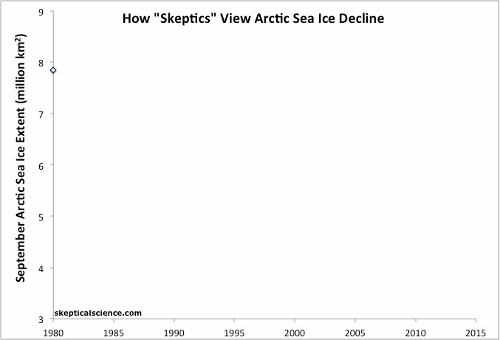
And of course there's the wildly popular original Escalator showing the surface temperature record:
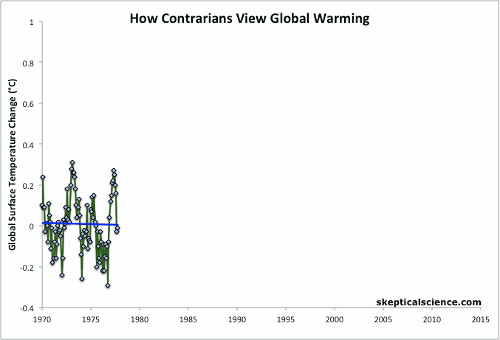
-
Rob Painting at 05:56 AM on 29 July 2015Conspiracy theories about Skeptical Science
No! I am SpartaCook!
-
blink937 at 03:44 AM on 29 July 2015CRU tampered with temperature data
"Independent Climate Change Email Review". That title in itself is laughable. The UEA funded the review themselves, how is that independent? Basically they paid someone to review themselves and found nothing wrong, sounds totally legit.
(snip)
Moderator Response:[RH] Please note that posting comments here at SkS is a privilege, not a right. This privilege can be rescinded if the posting individual treats adherence to the Comments Policy as optional, rather than the mandatory condition of participating in this online forum.
Please take the time to review the policy and ensure future comments are in full compliance with it. Thanks for your understanding and compliance in this matter.
Unsubstantiated accusations deleted.
-
Rob Honeycutt at 03:12 AM on 29 July 2015Conspiracy theories about Skeptical Science
No! I am Sparti... er, John Cook! :-)
-
CBDunkerson at 02:59 AM on 29 July 20152015 SkS Weekly News Roundup #30B
Correction to #1 above. Coal is not just dying. Coal is on it's death bed and life support is failing.
Heard of Peabody Energy? Largest coal company in the world? 2011 share price: $73. Today's low share price: $0.99. It's literally a penny stock.
The collapse of investor support for coal is nearly complete. The, directly linked, collapse of political support for coal is already well underway. We've passed the tipping point... all the political benefits which have been propping up coal for decades will now shortly be withdrawn and replaced by impediments. That will transition coal cost competitiveness from 'barely hanging on' to 'completely hopeless'. The US is ahead of the curve on this, but the rest of the world will follow much sooner than most projections of future coal use have suggested. I'll be surprised if coal use isn't falling world wide by 2020.
Too soon to call when petroleum will follow suit. Probably all down to when electric car batteries become cost competitive.
-
CBDunkerson at 02:29 AM on 29 July 2015Conspiracy theories about Skeptical Science
Let's assume that Wadhams really did say everything claimed without any qualifiers or exceptions. We would then be talking about a single person, with a single conspiracy, having nothing to do with the actual science. The 'skeptic' rush to highlight this as a counter to their many conspiracy theories, in and of itself, is a perfect demonstration of just how absurdly pathetic their position is.
-
ryland at 02:20 AM on 29 July 2015Conspiracy theories about Skeptical Science
And BTW your comment "Does it affect the substance of the science on climate change? No, of course not." is expressing very similar sentiments to those in the comment I made "But even if he did make the remarks does it really make that much difference to the debate on Climate Change?" Perhaps that had escaped your attention as indeed it did mine until I re-read the comments.
-
ryland at 01:52 AM on 29 July 2015Conspiracy theories about Skeptical Science
KR Yes I did read the text
I don't recall I said I believed anything. What I stated was that Professor Wadhams may have made the claims he now denies or the Times is being extremely foolhardy in publishing the piece. I cannot see where this is expressing a belief one way or another,. And would you point out where I showed any willingness to believe conspiratorial thinking as I said "and even if he did" which is a long way from saying "he did".
-
KR at 01:20 AM on 29 July 2015Conspiracy theories about Skeptical Science
ryland - As an addendum, I find your willingness to believe conspiratorial thinking on the part of a single climate researcher quite interesting in contrast with your comments on the "Recurrent Fury" thread - where you spent quite some time arguing about (non-existent) ethical issues in an apparent attempt to denigrate a paper on climate denialist conspiratorial thinking. Most curious.
-
KR at 01:13 AM on 29 July 2015Conspiracy theories about Skeptical Science
ryland - Did you actually read the linked text? Because Wadham bracketed what he characterizes a brief suspicion (one prompted by the reporter) with statements that the climate researchers deaths were clearly coincidence, context that the Times did not include. And he stated he "...did not make any of the statements enclosed in quotation marks by the reporter." Out of context characterizations, with manufactured quotes???
I view the Times article, and the denial blogosphere fuss about it, simply as a Tu quoque fallacy - an attempt to distract from the well recognized and currently well publicized conspiracy ideation of climate denialists. Does it affect the substance of the science on climate change? No, of course not. Does it reflect poorly on the journalistic integrity of the Times? Yes, yes it does, and if Wadhams statement holds up the Times may be liable.
-
BBHY at 21:09 PM on 28 July 20152015 SkS Weekly Digest #30
The fossil fuel industry has profits in the billions and reserves worth trillions, so they have great incentive to push denial and doubt about climate science.
Scientists are smart people. If they were driven by greed, they would probably be bankers or lawyers or some other more lucrative occupation. They are scientists because they quest for knkowledge, not riches.
The idea that fossil fuel industry funded people are telling us the truth and scientists are lying conspiritorists is beyond crazy.
-
Tom Curtis at 20:32 PM on 28 July 2015Arctic sea ice loss is matched by Antarctic sea ice gain
bozza @19, there is a coriolis effect in the NH just as in the SH, and vice versa. What causes that effect to have different consequences in the SH than in the NH is the different distributions of land and water; which also has other consequences on climate independent of the coriolis effect. So if you want to reduce it to a simple formula; the NH polar regions are warmer than the SH polar regions because the Arctic is water surrounded by land, while the Antarctic is land surrounded by water. Differences in distribution of land and water also explains the more southerly location of the tropical zone, and the slower loss of temperature with latitude in the SH temperate zone relative to the NH temperate zone.
That said, it is a mistake to reduce things to that level of simplicity. When you do, deniers swoop in and pick out a minor factor claiming it was "ignored by climate scientists" and that "it is the real cause". And although those claims are rubbish, depending for their rhetorical effectiveness on people not having had those other factors discussed before hand, by oversimplifying the scientific story we are just setting people up for those pseudoscientists.
-
Kevin C at 15:48 PM on 28 July 2015The Skeptical Science temperature trend calculator
What Tom said - I'm doing 60+ hours most weeks counting crystallography + climate stuff, plus domestic duties.
Also I can't update the applet page here - only the data. Updating the applet needs an intervention from the (also over-stretched) technical people. The version of the applet on my York page is more up to date - it has some tooltips and auto-updating. I don't think I've updated the links though - sorry.
Karl krig is the gridded data from the Karl 2015 paper fed through the C&W version 1 kriging calculation from our paper - i.e. infllling the blended data. I let the calculation work out the kriging range for itself - given that the Karl maps are smoothed, this is slightly overestimated (IIRC 850km - 750 is more realistic). However infilling the blended data rather than infilling separately will also underestimate the trend because part of the Arctic will be filled in from SSTs. I don't know which effect will be bigger, so for now it's just a best guess on what the global Karl data will look like.
-
ryland at 15:10 PM on 28 July 2015Conspiracy theories about Skeptical Science
KR @6 In the link you gave regarding Professor Wadhams this comment is made:
"A spokesperson for The Times said: “We have a recording of Professor Wadhams making these statements. Another newspaper [the Telegraph] subsequently reported that he had made similar comments to their journalist. We stand by the story.”
In view of the wiilingness to sue news outlets at what seems to be the drop of a hat, it would seem Professot Wadhams may have made the claims he now denies or that the Times is being extremely foolhardy in publishing the piece. But even if he did make the remarks does it really make that much difference to the debate on Climate Change?
-
bozzza at 14:25 PM on 28 July 2015Arctic sea ice loss is matched by Antarctic sea ice gain
So, arriving at a simple answer, coriolis effect explains why the nothern hemisphere is warmer than the southern!!?
-
Tom Curtis at 09:46 AM on 28 July 2015The Skeptical Science temperature trend calculator
s_gordon_b @86, I agree that it would be nice if it were spelled out explicitly. Having said that, everything produced on SkS is done by volunteers who are not paid for their contribution, and certainly not paid for their time producing material for SkS. (This may or may not apply to pieces published for the Guardian, although if Dana is paid for those pieces, I suspect it is a pittance.) Further, many of the contributors are very busy, having a lot of other demands on their time. Given the volunteer nature of the excercise, we are not entitled to any further expectation on their time. If Kevin C (who I know to be very busy), does not have time to update the post - then that is just how it is. We should just continue to appreciate that he has made so much time available free for out benefit as it is.
So, if he hasn't the time for the update, you can always indicate that you "think this is what the data refers to", but that the volunteers have not had the time to clarrify as yet - linking to this post if need be.
-
Tom Curtis at 09:37 AM on 28 July 2015Conspiracy theories about Skeptical Science
I have just been emailed by Scott Gates (who I do not remember, and certainly have had no correspondence with under that name) making scurrilous accusations relating to Lubos Motl's accusations. I consider his accusations libelous, and will not repost them, but I will post my response:
"I don't know you from a bar of soap, and do not appreciate being mail bombed with your scurrilous and false accusations.
The facts are:
1) John Cook used the pseudonym "Lubos Motl" only on a private forum, where all other members were aware that it was a pseudonym. Ergo it was no more identity theft than using somebodies name to perform a parody, or manufacturing fake quotes in somebodies name in a cartoon (as is regularly done by Josh in cartoons published on WUWT). If any pseudoskeptic has a problem with the practice, they should first take it up with Anthony Watts and Josh.
2) The use of the pseudonym was not in anyway related to the 97% consensus paper, nor in Recursive Fury or Recurrent Fury (the follow on papers to the Moonlanding paper by Lewandowsky). Nor has it been used as data for any published scientific paper by John Cook. This point is made in an update to the link you provide on the story.
3) The non-accidental uses of the pseudonym was intended for research that was not published. For that research, the posts were used under a different pseudonym not associated with any person known (and certainly not with any well known scientists, a category that does not include Motl). It is less than ideal to use manufactured samples in research of that category because of the possibility of unconscious biases being introduced to the writing style. It does not, however, constitute scientific fraud unless the fact that the examples of "pseudoskeptic arguments" were written by non-pseudoskeptics is concealed in the published work. It is an arguable point as to whether failure to explicitly acknowledge the manufactured samples in the published work constitutes fraud, but there is no doubt that explicitly mentioning it is best practice. These same points apply also to manufactured examples of "consensus" arguments by people who accept the consensus, even if writing in their own name; because again, the contrived situation may lead to subtle biases in the samples (perhaps making the arguments more cogent than is typical of pro-consensus comments). (I should note that the use of non-manufactured samples also raises ethical issues relating to consent, so despite the issues discussed in this paragraph, the use of manufactured samples, properly acknowledged as such, may in fact be the best scientific practice for this type of research once all considerations are taken into account.)
4) Regardless of the considerations in (4), to my certain knowledge, John Cook has not intentionally practiced scientific fraud in any of his research, published or unpublished. Suggesting otherwise constitutes libel, and is considerably more unethical than anything John Cook has done."
The link provided, and mentioned in point (2) above, was to WUWT.
-
John Hartz at 08:57 AM on 28 July 2015Conspiracy theories about Skeptical Science
Suggested supplementary reading...
Why Do Some People Believe in Conspiracy Theories? by Christopher French*, Scientific American, June 11, 2015
*Professor of psychology at Goldsmiths, University of London
-
s_gordon_b at 08:46 AM on 28 July 2015The Skeptical Science temperature trend calculator
Tom @85, I agree with your speculations, but continue to wish SkS would spell these things out so there's no room for ambiguity. If I want to post a chart from their calculator to my blog, for example, describing it as "I think this is what the data refers to..." doesn't inspire confidence in me or SkS.
-
jake7351 at 08:23 AM on 28 July 2015Conspiracy theories about Skeptical Science
Suprised that Pielke was so eager to promote the Lubos nonsense. He must of had an inkling there was an explanation. He still can't admit it and instead is talking about Nazis. *sigh*
-
longjohn119 at 08:02 AM on 28 July 2015Conspiracy theories about Skeptical Science
"I consider myself a value driven conservative: ...."
I'm old enough to remember a time when you didn't have to add a qualifier before Conservative to explain you were different from the rest. That's why I called Republicans Fictional Conservatives to point out how far off track they've gone since Reagan and the NeoCons
"I feel very definitely that the administration is absolutely correct in cracking down on companies and corporations and municipalities that continue to pollute the nation's air and water. While I am a great believer in the free competitive enterprise system and all that it entails, I am an even stronger believer in the right of our people to live in a clean and pollution-free environment.
To this end, it is my belief that when pollution is found, it should be halted at the source, even if this requires stringent government action against important segments of our national economy."
- Barry Goldwater, 1969
-
Jim Hunt at 04:36 AM on 28 July 2015The importance of good climate communication: a recent Arctic example
This story has taken a couple of intriguing turns already today. Over the weekend the Mail, Telegraph & Times accused Prof. Peter Wadhams of wearing a tinfoil hat.
Then Prof. Wadhams complained to the UK's Independent Press Standards Organisation about recent articles that “ha[ve] substantially damaged my reputation for scientific integrity, and I believe that this was the deliberate intention”:
http://GreatWhiteCon.info/2015/07/professor-peter-wadhams-complaint-to-ipso/
Now the Guardian says the Times says it has a recording of the interview that started the whole Wadhams bashing juggernaut rolling.
-
Tom Dayton at 04:18 AM on 28 July 2015Conspiracy theories about Skeptical Science
jgnfld: But I have a PhD in cog sci with heavy emphasis on stat, and I have been commenting on that CNN thread! This consipiracy goes really deep! Apparently I've been posting as you without knowing it, so I guess I'm really John Cook but I've been masquerading so long that I've lost track of who I really am. Did I eat lunch yet today?
-
knaugle at 04:07 AM on 28 July 2015Increasing CO2 has little to no effect
@Rob Honeycutt
I know I'm 5 months after the fact, but Jim (in CA) commonly posts to climate stories in the Yahoo! News blogs. He and another character who goes by JDAM, love to quote all sorts of Boltzman calculations as "proving" that CO2 can't possibly be a GH gas. Problem is they would never be convinced that their black box calculation of 1°C per double CO2 misses about half the reality, feedbacks, associated with increasing GHG concentrations as some other later folk pointed out.
-
KR at 03:05 AM on 28 July 2015Conspiracy theories about Skeptical Science
Langham - Note that Dr. Wadhams has complained to the Independent Press Standards Organization (IPSO) regarding that article, saying that "I did not make any of the statements enclosed in quotation marks by the reporter."
Seems like the Times (not to mention the Telegraph, and Mail) continues with the (ahem) fine non-journalistic tradition of junk stories. Wrapping garbage with that paper would insult the garbage.
-
Langham at 02:38 AM on 28 July 2015Conspiracy theories about Skeptical Science
It seems there are conspiracy theorists on both sides of the debate: http://www.telegraph.co.uk/news/earth/environment/globalwarming/11762680/Three-scientists-investigating-melting-Arctic-ice-may-have-been-assassinated-professor-claims.html
-
KR at 01:18 AM on 28 July 2015Conspiracy theories about Skeptical Science
It may be a good idea to use web archives such as the WayBack machine or archive.is for such links.
-
KR at 01:16 AM on 28 July 2015Conspiracy theories about Skeptical Science
The "...surmise he may just be a front for the IPCC or Globe International..." link is dead, climatechangedispatch apparently doesn't have the page up anymore.
The archived link for it works, though, and you might want to use that instead.
-
jgnfld at 23:51 PM on 27 July 2015Conspiracy theories about Skeptical Science
John C...
You will note that one of the more active deniers on the CNN article decided that I (jgnfld there too) am a John Cook sock puppet. :-o
I guess that was a pretty nice compliment!
Oddly, I have a PhD in cognitive psych with a large stats emphasis. From the late 70's, however.
-
Jonas at 19:09 PM on 27 July 2015Conspiracy theories about Skeptical Science
I donate to SkS. But I did not know I was a billionaire. If I find that money on my accounts, I will donate much more than the 100$ per year, thanks for the hint! These denial people seem not to know charitable engagement in their neighborhood: billions of people worldwide work many billions of unpaid hours, daily. In fact, large parts of global work in families and for the elderly are unpaid. SkS is work for the families and the future elderly alike, simply on a more basic level than direct caring.
I consider myself a value driven conservative: the difference is: I care about preserving nature/the climate and not about preserving the profits of fossil oil/gas/coal millionaires and billionaires and I like to think about about this (religiously and non religiously grounded) value of solidarity, globally and intergenerationally. Freedom is not the right to destroy the world or harm other people, but to thrive in the boundaries given by our world (and god, if you like) and all other humans and beings.
-
Adrian Vance at 11:33 AM on 27 July 2015Global warming deniers are an endangered species
CO2 is a “trace gas” in air, insignificant by definition. It absorbs 1/7th as much IR, heat energy, from sunlight as water vapor which has 188 times as many molecules capturing 1200 times as much heat making 99.8% of all "global warming." CO2 does only 0.2% of it. For this we should destroy our economy?
There is no "greenhouse effect" in an atmosphere. A greenhouse has a solid, clear cover that traps heat. The atmosphere does not trap heat as gas molecules cannot form surfaces to work as greenhouses. Molecules must be in contact, as in liquids and solids to form surfaces.
The Medieval Warming from 800 AD to 1300 AD Micheal Mann erased for his "hockey stick" was several Fahrenheit degrees warmer than anything "global warmers" fear. It was 500 years of world peace and abundance, the longest in history.
Vostock Ice Core data analysis show CO2 increases follow temperature by 800 years 19 times in 450,000 years. Thus temperature change is cause and CO2 change is effect. This alone refutes the anthropogenic global warming hypothesis.
Methane is called "a greenhouse gas 20 to 500 times more potent than CO2," by Heidi Cullen and Jim Hansen, but it is not per the energy absorption chart at the American Meteorological Society. It has an absorption profile very similar to nitrogen which is classified "transparent" to IR, heat waves and is only present to 18 ppm. "Green vegans" blame methane in cow flatulence for global warming in their war against eating meat.
Carbon combustion generates 80% of our energy. Control and taxing of carbon would give the elected ruling class more power and money than anything since the Magna Carta of 1215 AD.
Most scientists and science educators work for tax supported institutions. They are eager to help government raise more money for them and they love being seen as "saving the planet."
Google "Two Minute Conservative" for clarity.
Moderator Response:[PS] Welcome to Skeptical Science. Thank you for taking the time to share with us. Skeptical Science is a user forum wherein the science of climate change can be discussed from the standpoint of the science itself. Ideology and politics get checked at the keyboard.
Please take the time to review the Comments Policy and ensure future comments are in full compliance with it. Thanks for your understanding and compliance in this matter.
In particular, please note all comments must be on topic andno sloganeering. "Gish Gallops" of talking points will be deleted. Use the search function to find an appropriate topic but read the topic first. All of your points were long debunked myths. If you wish to challenge this, you need to provide data and references to back your viewpoint. I strongly urge you to get your information from informed and reliable sources.
-
Tom Curtis at 10:02 AM on 27 July 2015Arctic sea ice loss is matched by Antarctic sea ice gain
Rovinpiper @15, the coroilis effect leads to circular patterns of motion in air and sea currents because the coroilis "force" is always at right angles to the direction of motion of the wind or sea current, as illustrated below:

Around the north and south poles, this leads to a permanent circumpolar vortex which helps prevent the flow of warm are from the south above the Arctic or below the Antarctic circle. There are differences between them. Specifically:
"Large hemispheric differences in the polar vortices can be seen in Figure 1: The Antarctic vortex is larger, stronger (more rapid westerlies), and has a longer lifespan than its Arctic counterpart. These differences are caused by hemispheric differences in the wave generation and propagation. The larger topography and land-sea contrasts in the NH excite more/larger planetary-scale Rossby waves that disturb the stratospheric vortex and push it farther from radiative equilibrium than in the SH. The hemispheric differences in the strength and, in particular, coldness of the polar vortices are extremely important for understanding ozone depletion, as explained below."
Because the Antarctic polar vortex is larger, it keeps the warm air further from polar regions. Because it is stronger, it more effectively insulates Antarctica. Further, because the Arctic polar vortex is less stable, it often moves far from its central position with the effect that frigid air is brought into temperate regions, and warm air is pumped into the Arctic.
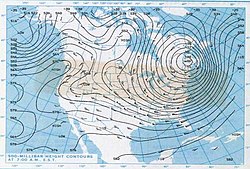
The difference is stability is a direct consequence of the fact that the Arctic is water surrounded by (very cold in the winter) land, whereas the Antarctic is land surrounded by relatively warm water.
More important than the atmospheric polar vortex are the circumpolar currents found around Antarctica (also caused by the coriolis effect), which limit the ability of warm water from reaching the coastline of Antarctica.
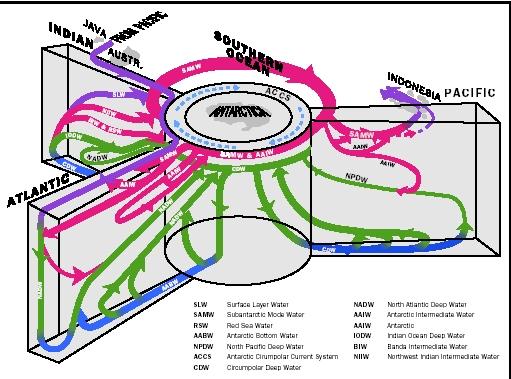
Obviously these circumpolar currents are only able to form because Antarctica is land surrouned by water. In the NH, no such currents form. Instead , the Eurasian landmass diverts part of a tropical current (the Gulf Stream) north, carrying warm water deep into the Arctic ocean. There is also a smaller, seasonal warm current through Berring Strait:
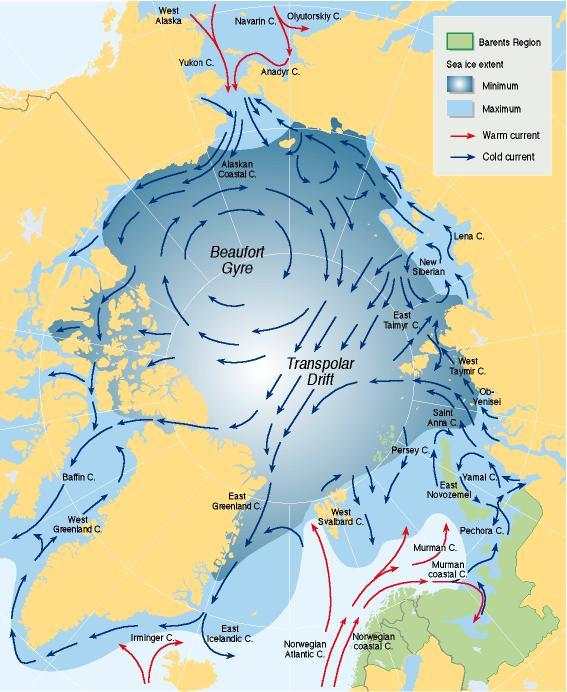
The effect of this is two fold. First the Norwegian Current (the extension of the Gulf Stream) keeps waters as far north as Svalbad unfrozen in winter in the North Atlantic (in current conditions). Second, because the water enters the Arctic ocean at the Norwegian current, it must exit somewhere else, and much of it exits in two cold currents flanking Greenland (part of the reason Greenland has preserved it's ice sheet).
This difference in ocean currents is the primary factor in differences in heat transport to the poles, which in turn is a major factor in the difference between Arctic and Antarctic ice levels.
There are additional factors, including the facts that:
- The Antarctic ice shelf has a very high altitude leading to a substantial cooling of the interior.
- When ice forms in the Arctic ocean, the remaining water is hypersaline, causing it to be very dense, and consequently sink. That in turn carries the cold water away from the bottom of the ice, drawing in warmer water from further south - a factor which limits the depths to which ice can form.
- Liquid water cannot exist much below 0oC. In contrast, the earth and rock can drop to much lower temperatures. That means the Arctic ice, sitting over water cannot be much cooler than 0oC (although the air mass above it in winter, which is insulated by snow from the ice, can be). In constrast, land ice on Antarctica and Greenland can fall to much lower temperatures.
- Even where the ice does melt, rock and soil typically have a much higher albedo than does open water (although given the thickness of the land ice involved, this is a very minor factor).
Of the five factors (ie, difference in heat transport plus the four listed above), it is not clear as to their relative importance, although I think the evidence is stronger for the differences in heat transport being most important (and overwelhming that item 4 in the list is the least important).
-
scaddenp at 06:34 AM on 27 July 2015Arctic sea ice loss is matched by Antarctic sea ice gain
The really big factor is height. The south pole is at 2700m - making it a much colder place than North pole. Raising the summer temperature from current -29C to say -9C still wouldnt do much melting. Furthermore, arctic ice is constantly moving with combination of wind and currents. Moving ice from somewhere cold to somewhere warm is much more effective at melting than inplace melting. In the antarctic, ice movement is at literrally glacial pace. The oceans also bring in warmer water which thins arctic ice but so far only affects the antarctic margin.
-
CBDunkerson at 06:30 AM on 27 July 2015Arctic sea ice loss is matched by Antarctic sea ice gain
Rovinpiper, Arctic sea ice averages less than two meters thick. Antarctic land ice averages more than 1800 meters thick. See the problem?
-
Rovinpiper at 06:15 AM on 27 July 2015Arctic sea ice loss is matched by Antarctic sea ice gain
Ok, so why is the fact that there is land at the South Pole so important? Ice can melt on land, too. Open ocean absorbs heat very well, but what is the rock of Antarctica like? How well will it absorb heat?
-
Tom Curtis at 22:05 PM on 26 July 2015Arctic sea ice loss is matched by Antarctic sea ice gain
bozza @13, there are three different things that could be meant by a claim that the NH is 'warmer than' the SH.
First, it might be a claim that the annual variation is surface temperature is greater in the NH than in the SH, as shown in this chart:
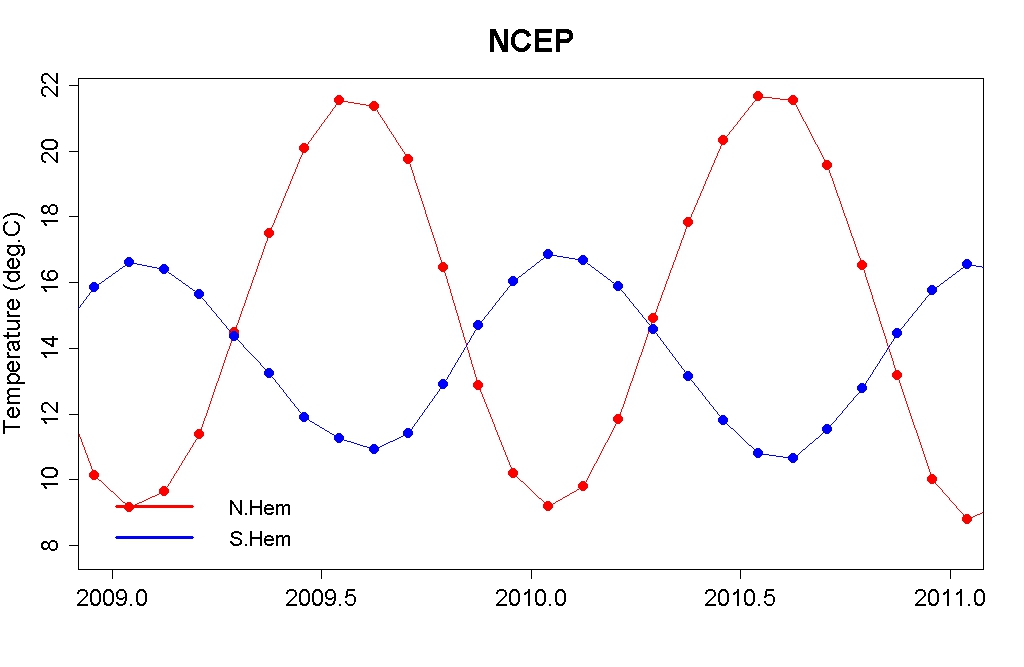
This greater variation results in the seasonal variation in global mean temperatures being in phase with the NH variation, even though the SH in fact recieves more sunlight over the year. The reason for this difference is the relatively low thermal inertia of the NH (which is 39% land) compared to the SH (which is only 19% land).
The same factor is the dominant factor in the more rapid rise in mean hemispheric temperatures in the NH since 1950 (the second possible interpretation), shown here:

Neither implies that the NH is actually warmer than the SH in absolute terms, as a more rapid warming response also implies a more rapid cooling response. In fact, it appears that in absolute terms, the SH is warmer than the NH:
"Data from a large number of stations suggest that the annual mean temperature is around 27o C within 20o S - 16o N degrees and then falls by about 0.85 K/degree latitude in the northern hemisphere and 0.63 K/o lat in the south (Fig 2). This implies that on average the southern hemisphere is warmer than the northern hemisphere (17oC vs 11oC, respectively), which is true, if the Antarctic plateau stations are excluded, as in Fig 2. These stations are 30-40K colder than the curve in Fig 2 suggests, on account of their altitude and their isolation within the circumpolar vortex."

It may be that the very cold Antarctic temperatures more than compensate for the greater extent of tropical warmth in the SH, and the slower loss of temperature with higher latitude. But I have no evidence showing that to be the case.
Regardless, the cause of these differences are complex, including the effect of the positions of landmasses and currents on the location of the Inter Tropical Convergence Zone (which would govern the latitudinal extent of the tropical zone) and the relative ease of heat transport towards the poles in the two cases. Part of the explanation may lie in the circumpolar vortex around Anarctica, which by limitting heat transport to the pole may allow that heat to remain in mid-latitudes in the SH rather than being transported to the pole (or at least above the arctic circle) in the NH.
-
bozzza at 21:09 PM on 26 July 2015New Zealand Snow No Show = No Jobs
Not sure where to ask about global snowlines but is the data available for say 50 years of global snowlines to establish trends?
-
bozzza at 17:38 PM on 26 July 2015Scientific consensus and arguments from authority
Science is done by consensus and it starts with nomenclature!
-
Jim Hunt at 17:34 PM on 26 July 20152015 SkS Weekly News Roundup #30C
Regarding the "Tory attacks on green policies", Tony Juniper was good enough to "retweet" a recent message of mine on this very topic:
https://twitter.com/jim_hunt/status/624483364679061504
Might I suggest that any UK citizens reading this follow my example and Lord Deben's suggestion and write to their own Member of Parliament about the issue at their earliest possible convenience?
-
bozzza at 16:54 PM on 26 July 2015Arctic sea ice loss is matched by Antarctic sea ice gain
Tom @ 12, in a nutshell is this why the Northen Hemisphere is warmer than the Southern Hemisphere?
I've been looking for the simple explanation as to why this is because apparently it was theorised many moons ago but the mechanism for it being so was not quite understood.
-
Tom Curtis at 15:38 PM on 26 July 2015It's the sun
Just a small extension to MA Rodger's analysis of Dan Pangburn's 'model' @1149. What I did was obtain the sunspot numbers and annual average TSI figures from SORCE for the years 1979-2013 (ie, the satellite record). I calculated the equilibrium temperature response for each sunspot number as:
T(eq) = 286.2*(S(i)/34)^0.25
At that value, S(i) = 34 * (T(i)/286.2)^4, and hence S(i) - 34 * (T(i)/286.2)^4 = 0, ie, there is no temperature change using Pangburn's model.
Using the equilibrium temperature for the sunspot number of a given year, and the forcing (=0.7*TSI/4) for each year from SORCE, I calculated the linear trend of temperature relative to forcing, a value which give the ECS. It turns out to be 1447 +/- 194 K/Wm-2.
This differs from MA Rodger's estimate because, his upper bound on the forcing massively overestimates the forcing differential. In particular, in 1987 the sunspot number was 33.9, with an insolation of 238.19 W/m^2, a value that differs by only 0.015 W/m^2 from the average over the period. Ergo Rodger's overestimated the forcing differential by a factor of 66.67.
-
LarryM at 06:59 AM on 26 July 20152015 SkS Weekly News Roundup #30C
Links in article "How this El Nino..." are missing above and on homepage.
[feel free to delete this comment once dealt with]
Moderator Response:[JH] Glitch fixed. Thank you for bringing this to our attention.
-
Tom Curtis at 05:58 AM on 26 July 2015It's the sun
MA Rodger @1149, 0.003503/17 = (approx) 0.0002. You have misplaced a decimal point. Further, the temperature term takes the fouth power of the ratio between T(i) and T(o), not ratio between T(i) and T(i-1). Consequently it is not always negligible, and is certainly not negligble at T(i) = T(o) + 60. Of course, you did not neglect that in calculating the equilibrium temperature. Neglecting the temperature ratio changes the time to equilibrium but not the equilibrium temperature. That, as you know, is determined solely by the requirement that at equilibrium (T(i)/T(o))4 = s(i)/34, resulting in the integrated term in Pangburn's formula equalling zero. I estimate the increase in temperature at equilibrium to be +62.59 C, or given the baseline temperature, at 75.6 C. Ignoring the misplaced decimal point, a neat analysis, and "lunatic value" is exactly correct.
-
MA Rodger at 04:19 AM on 26 July 2015It's the sun
Tom Dayton @1147/1148.
I think the two previous excursions of Dan Pangburn here @SkS do not provide a clear explanation of Pangburn's proposition, possibly even less clear than Pangburn's explanation linked to by APT @1146.
APT @1146.
The graphs you link to are simple nonsensical curve-fitting with zero basis in physics. The guts of Pangburn's sunspot equation can be much simplified and still produce the same-shaped resulting graph. That simple equation is:-
- T(i+1) = T(i)+0.00002(S(i)-34)
where T is temperature and S is sunspot number for year i.
For the last 75 years, the average sunspot number has been about 75, way above the average 34 used in the equation which is why the graphed temperature soars despite the heavily lagging terms employed. Indeed, it is only during the Manuder Minimum & the Dalton Minimum that the average sunspot number drops below 34 allowing Pangburn's graph to dip downward. Including SSN data to 2014 shows that even weak Sunspot Cycle 24 is averaging above 34 and showing a further increase in temperature.
Heavy lagging is used by Pangburn because the T4 term is far too weak to define an equilibrium temperature. If the ~75 average sunspot number of recent decades persisted, the equation tells us global temperatures would rise by over 60ºC before equilibrium appears. Given the forcing involved will be less than 1Wm-2, this means this equation of Pangburn's is suggesting an Equilibrium Climate Sensitivity ECS > 240ºC, an entirely lunatic value.
-
Jim Hunt at 00:50 AM on 26 July 2015The importance of good climate communication: a recent Arctic example
Thanks for your kind words John!
I've now "Storified" recent Twitter conversations with the likes of David Rose and Andrew Neil, and added the result to the article you just linked to. Here's how it looks just at the moment, but I cannot help but feel that this particular story still has (long!) legs:
Inconvenient Truths for the Daily Mail and The Spectator
It's interesting that two right-wing publications in the UK simultaneously attack climate policy by throwing jabs at climate science.
-
Tom Dayton at 00:48 AM on 26 July 2015It's the sun
APT: Dan Pangburn re-appeared in a recent comment. Read the responses there.
-
Tom Dayton at 00:46 AM on 26 July 2015It's the sun
APT: Dan Pangburn, the author of those claims, commented here on SkS several years ago. Please read the responses.
Also, the cooling stratosphere is incompatible with increased energy from the Sun.
-
APT at 23:08 PM on 25 July 2015It's the sun
Hello,
I'm curious about the graphs shown here: http://hockeyschtick.blogspot.com.es/2014/08/its-sun_9.html
and here:
http://hockeyschtick.blogspot.com.es/2013/11/the-sun-explains-95-of-climate-change.html
Clearly this isn't published, peer-reviewed science, but I'd like to know if there's any sense to it, and if not, to understand what the problems with it are. I know a little about climate change, particularly regarding reconstructions of past environments, but I'm out of my depth trying to understand these sunspot calculations.
Many thanks.Moderator Response:[TD] Hotlinked the URLs. In future please do that yourself with the link button in the comment editing controls.
-
Tom Curtis at 20:37 PM on 25 July 2015Arctic sea ice loss is matched by Antarctic sea ice gain
Rovinpiper @11, not it is not. That is because the Arctic is an ocean surrounded by land, while the Antarctic is land surrounded by ocean. The important effect of that is that while in principle summer sea ice in the Arctic can shrink to zero, thereby exposing the entire Arctic ocean with its much lower albedo than sea ice; the Antarctic sea ice shrinking to zero still effectively left the entire polar region above 70 degrees south covered by land ice, and hence maintaining the same albedo. As the Arctic sea ice shrinks will within that 70 degree circle, the consequence is a much larger Arctic impact on seasonal albedo.
This is discussed in the intermediate version of the original post.
Prev 576 577 578 579 580 581 582 583 584 585 586 587 588 589 590 591 Next































 Arguments
Arguments



























